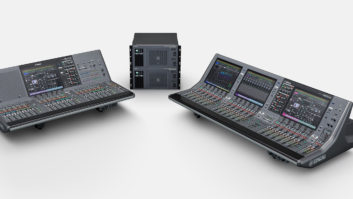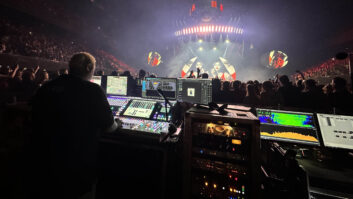
Las Vegas, NV—Mariah Carey’s music is tailor-made for Las Vegas, packed with driving beats and good-time vibes, all of which makes her ongoing series of residencies at the Colosseum at Caesars Palace in Las Vegas that much more exciting. The most recent run, The Butterfly Returns, finished up its eight-show stint just before the COVID-19 pandemic kicked in, treating fans nightly to a string of greatest hits from across her career. Veteran engineer Phil Strong has mixed Carey’s live shows since early 2019, manning the FOH desk for a summer tour and three rounds in Vegas so far.
Setting up shop at the Colosseum for two-week runs gives Strong time to delve into the acoustics of the 4,300-seat venue and further optimize the show’s sound as time goes on. That effort is aided by the house audio system, which received a top-to-bottom renovation last summer. The setup is now centered around a Solotech-provided Meyer Sound Leo Family system anchored by Lyon arrays, which replaced the Meyer system that Solotech installed there in 2003.
“The new system has been really cool,” Strong confirmed. “It’s much more coherent and offers a lot of bells and whistles in terms of how you can manage it. Being there for a couple of weeks, too, allows you to really dig into it. You get some things done that you can’t on the fly when you’re on the road, where you’re worried about getting the show up and making sure everything’s functional.”
Related: Rebuilding the Colosseum with Meyer Sound, Dec. 16, 2019

That flexibility came into play during Carey’s residency last November. Throughout the year, Strong had been using a Midas ProX console, aiming for an analog-like sound, but with maxed-out 9650 ports and other issues that came up during shows last summer in Europe and Saudi Arabia, he opted to start over. “I made the switch to a DiGiCo SD7 Quantum and rebuilt my whole show file from the ground up—which was cool,” he said. “Rupert Neve Designs sent me a 5059 Satellite summing bus. I wanted to try doing some summing outside of the console and it went well. I also added my UAD2 Live Rack to the system and some Bricasti M7s, too. Reprogramming the whole show, I was able to snapshot automate different musical changes that I need to do via timecode, which is great. The timecode gets everything from Ableton, so I run that right into the console, and I was able to write the snapshots for different reverb changes and other things that needed to happen quickly. New P.A., new console, new effects—I had everything I needed and got to play with it, A-and-B stuff and try new ideas.”
A lot of those ideas were about using different UAD plug-ins to fine-tune the show to perfection. For instance, getting the snare right was crucial—a factor that sent Strong on a quest, working through a string of plug-ins until he settled on the API 2500 Bus Compressor: “That was exactly what I was looking for. It helped me control the snare on the hard hits and keep the rim shots right where I needed them—there’s a significant amount of rim-shotting in the show, because, you know, R&B ballads. I can get the snare to sit exactly where I want it to and give that nice ’90s R&B sound as well, so using that in conjunction with the Lexicon 224 digital reverb plug-in, I can emulate some of those great ’90s snares that I need for her. It’s amazing.”
Related: Live Sound Showcase: Vampire Weekend Goes 360° at MSG, by Larry Jaffee, Sept. 27, 2019
Strong puts some other favorite UAD plug-ins to work, too, such as the Manley Variable Mu on keyboards: “That Manley came through with flying colors. The Variable Mu is so clear and transparent and open, and it controls the level without squishing—no pulling and tugging. It has been amazing. It’s a fantastic plug-in.” Elsewhere, the 1176 Classic Limiter gets applied to the kick and bass.
The fans come to hear Carey’s amazing voice, however, and since it’s the focal point of the show, it’s also the focus of Strong’s attention. That voice is captured nightly via a Shure Axient Digital wireless with a Telefunken M81 capsule, and the plug-ins used on it are applied sparingly, with surgical precision, so as not to get in the way. For example, the UAD Neve 1073, used as a preamp to give the vocal a little more warmth. “I also use the Sonnox Oxford Dynamic EQ to control her powerful vocal,” he added. “She’ll go from joking with the crowd lightly to belting out 25 dB louder, so I get in there, grab the frequencies on the dynamic EQ and control it. Then in the final stage, I smooth it with the Summit TLA100, which still sounds natural even when it’s compressing. There’s moments where she hits her notes really quick—you want the compressor to engage, but you don’t want it to pull the vocal where it sounds like it’s getting cut off. The Summit doesn’t do that at all, so that’s been a really pleasant surprise that I have a TLA100 in a plug-in that works just as well as it does in tube form.”
All that technology isn’t for technology’s sake; it’s to support the show, the music and the artist as much as possible. “I mean, it’s Mariah Carey!” laughed Strong. “You want it to sound the way that it sounded on those records, because people know those songs in their DNA. You don’t want it to come out sounding different. I spend a lot of time making sure that it’s as close to as I can get it. I know she likes bass and it’s funny—every time she comes in, she tells me, ‘I love the bass. Turn up the bass!’ It’s great to get an opportunity to listen with her and get her input on what she wants to sound like.”
Re-creating the sound of classic tracks produced by the likes of Jermaine Dupri and Babyface, as well as any number of signature tunes written by Carey herself, requires creating a full, rich mix with a lot of dynamics without ever bringing attention to the mix itself. “I try to get out of the way,” said Strong. “My goal is to be as transparent to the audience as possible. I don’t want them to ever notice that there’s an engineer mixing. I just want them to fall in love with the music and her, and go home knowing that they heard everything—it was all there.”
Universal Audio • www.uaudio.com







